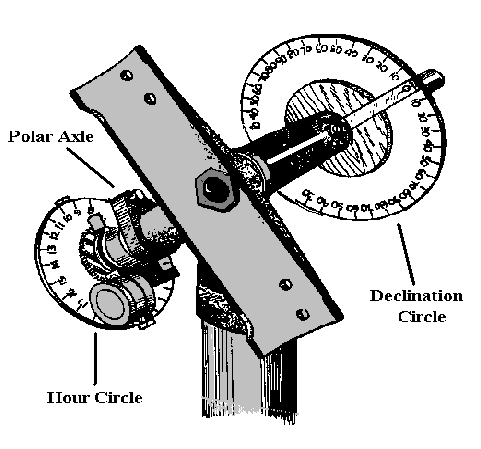Those Curious Things...Setting Circles
Jack Kramer
If you happen to own an equatorially-mounted telescope, there's a good chance that the mounting includes setting circles. And if you're like many of us, the chances are pretty good that you've never really used them, or perhaps just played around with them. The new computerized mountings have revolutionized the process to the point where using coordinates to locate objects is a snap. But here we'll consider just the plain old circles.
A traditional German equatorial mounting is illustrated at right. The polar axle holds the hour circle which is used to locate the object once you know its right ascension (RA), while the other axle has a declination circle graduated from 0o to 90o. (If you're unsure about some of these terms, you might want to dig out a prior newsletter article that dealt with the coordinate system.) On a typical Schmidt-Cassegrain scope, the declination circle is mounted on one of the arms of the fork mount. Once aligned with true north, the declination circle doesn't need to be reset. Not so with RA, and here we embark on the two methods of using setting circles. With or without a clock drive, the hour (RA) circle quickly loses its target -- as your polar axle follows the movement of a star, the circle reading changes. Either the pointer or circle remains stationary. The only way out would be to have the circle independently powered to follow the motion of the sky, and that gets complicated.
Method 1 -About the only time I've used setting circles is when there's been an object that I couldn't identify and needed to pinpoint its location on a chart. To do this, I've taken the easy way out - aimed at a bright star near my intended target, obtained its coordinates, then set the circles while still aimed at that star. So long as your scope is polar aligned and you work quickly, this does well enough to get you into the general area for another object, whether locating something on a chart or in the sky. In fact, this is the way computerized mountings work. If the coordinates of a mounting are aligned correctly for one or more known objects, then any other object also should be attainable by just setting the desired "go to" coordinates on the digital readout of the controller. With the clock drive running, you're set for the night -- the axles keep turning along with the heavenly vault. But the traditional RA circle is synchronized with the axle such that as the object moves, the RA reading keeps changing. So you constantly have to re-set the RA circle on the current object before you can move on to find another object. This is the easy way and is the method shown in the manuals that come with most new telescopes.

Method 2 - The traditional - old fashioned - method was necessary in the days when observatory instruments had huge circles that simply didn't lend themselves to being constantly reset. Finding an object in right ascension is very much time-dependent because diurnal movement carries the object across the sky while you're observing. Using method 2, you don't read the right ascension directly off the hour circle, rather you read the hour angle. We have to first know the sidereal time, and from this we subtract the right ascension of the intended object to get the hour angle of the object. For those who love formulas it's: ST - RA = HA.
Sidereal time is a measure of the Earth's rotation with respect to the equinox, rather than the Sun. A sidereal day is shorter than a mean solar day by 3min55sec.909. The way astronomers used to determine sidereal time was to set a clock so that it gains roughly 3min56sec per day. The starting point for setting a sidereal clock was derived using the Nautical Almanac. Computing sidereal time is a real pain. It may be what popularized star hopping among those who otherwise would have used setting circles! However, nowadays there are computer programs that give us the sidereal time directly. (We have one such program -- Astronomy Clock -- in the LCAS library.)
The steps are: sight on a bright star whose coordinates are known, compute the hour angle, then set the hour circle. To find another object, move the scope to the correct point on the hour circle for that object. There's no need to re-align the circle, but the hour angle of each new object must be calculated.
An old friend who's an experienced amateur astronomer commented about his observing group: "We have setting circles but find that they are more trouble than they are worth -- it's quicker just hopping to the objects." Amen!





